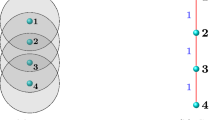Abstract
The paper investigates the structural controllability of leader-follower multi-agent systems under fixed and switching topologies. Three models of agents: double-integrator, high-order integrator and generallinear dynamics are analyzed. Necessary and sufficient graphical conditions are provided for structural controllability based on communication topology of the system. In particular, a linear neighbor-based control protocol is designed for generic linear agents under which structural controllability is proved to be uniquely determined by communication topology structure. The role that leaders play in the structural controllability of multi-agent system is characterized, and a method is developed to realize structural controllability under single leader. The results clearly indicate the role of leaders and the effect of communication topology on structural controllability.
Similar content being viewed by others
References
Olfati-Saber R, Murray R M. Consensus problems in networks of agents with switching topology and time-delays. IEEE Trans Automat Contr, 2004, 49: 1520–1533
Xie G, Wang L. Consensus control for a class of networks of dynamic agents. Int J Robust Nonlin Contr, 2007, 17: 941–959
Wang L, Xiao F. A new approach to consensus problems in discrete-time multiagent systems with time-delays. Sci China Ser F-Inf Sci, 2007, 50: 625–635
Cai H, Huang J. Leader-following adaptive consensus of multiple uncertain rigid spacecraft systems. Sci China Inf Sci, 2016, 59: 010201
Zheng Y S, Zhu Y, Wang L. Consensus of heterogeneous multi-agent systems. IET Contr Theor Appl, 2011, 5: 1881–1888
Zheng Y S, Wang L. Consensus of switched multiagent systems. IEEE Trans Circ Syst-II, 2016, 63: 314–318
Cheng L, Wang H, Hou Z G, et al. Reaching a consensus in networks of high-order integral agents under switching directed topologies. Int J Syst Sci, 2016, 47: 1966–1981
Ma J Y, Zheng Y S, Wang L. Topology selection for multi-agent systems with opposite leaders. Syst Contr Lett, 2016, 93: 43–49
Ma J Y, Zheng Y S, Wang L. Equilibrium topology of multi-agent systems with two leaders: a zero-sum game perspective. Automatica, 2016, 73: 200–206
Guan Y Q, Ji Z J, Zhang L, et al. Decentralized stabilizability of multi-agent systems under fixed and switching topologies. Syst Contr Lett, 2013, 62: 438–446
Guan Y Q, Ji Z J, Zhang L, et al. Quadratic stabilisability of multi-agent systems under switching topologies. Int J Contr, 2014, 87: 2657–2668
Tanner H. On the controllability of nearest neighbor interconnections. In: Proceedings of the 43rd IEEE Conference on Decision and Control, Bahamas, 2004. 2467–2472
Rahmani A, Ji M, Mesbahi M, et al. Controllability of multi-agent systems from a graph-theoretic perspective. SIAM J Contr Optim, 2009, 48: 162–186
Parlangeli G, Notarstefano G. On the reachability and observability of path and cycle graphs. IEEE Trans Automat Contr, 2012, 57: 743–748
Ji Z J, Lin H, Yu H S. Leaders in multi-agent controllability under consensus algorithm and tree topology. Syst Contr Lett, 2012, 61: 918–925
Notarstefano G, Parlangeli G. Controllability and observability of grid graphs via reduction and symmetries. IEEE Trans Automat Contr, 2013, 58: 1719–1731
Jafari S, Ajorlou A, Aghdam A G. Leader localization in multi-agent systems subject to failure: a graph-theoretic approach. Automatica, 2011, 47: 1744–1750
Zhao B, Guan Y Q, Wang L. Controllability improvement for multi-agent systems: leader selection and weight adjustment. Int J Contr, 2016, 89: 2008–2018
Liu B, Chu T G, Wang L, et al. Controllability of a leader-follower dynamic network with switching topology. IEEE Trans Automat Contr, 2008, 53: 1009–1013
Lu Z H, Zhang L, Ji Z J, et al. Controllability of discrete-time multi-agent systems with directed topology and input delay. Int J Contr, 2016, 89: 179–192
Ji Z J, Lin H, Yu H S. Protocols design and uncontrollable topologies construction for multi-agent networks. IEEE Trans Automat Contr, 2015, 60: 781–786
Guan Y Q, Ji Z J, Zhang L, et al. Controllability of heterogeneous multi-agent systems under directed and weighted topology. Int J Contr, 2016, 89: 1009–1024
Zamani M, Lin H. Structural controllability of multi-agent systems. In: Proceedings of the American Control Conference, Minneapolis, 2009. 5743–5748
Alireza P, Lin H, Ji Z J. Structural controllability of high order dynamic multi-agent systems. In: Proceedings of IEEE Conference on Robotics Automation and Mechatronics, Singapore, 2010. 327–332
Liu X M, Lin H, Chen B M. Graph-theoretic characterisations of structural controllability for multi-agent system with switching topology. Int J Contr, 2012, 86: 222–231
Wang L, Jiang F C, Xie G M, et al. Controllability of multi-agent systems based on agreement protocols. Sci China Ser F-Inf Sci, 2009, 52: 2074–2088
Lou Y C, Hong Y G. Controllability analysis of multi-agent systems with directed and weighted interconnection. Int J Contr, 2012, 85: 1486–1496
Goldin D, Raisch J. On the weight controllability of consensus algorithms. In: Proceedings of European Control Conference, Zurich, 2013. 233–238
Liu Y Y, Slotine J J, Barabási A L. Controllability of complex networks. Nature, 2011, 473: 167–173
Lin C T. Structural controllability. IEEE Trans Automat Contr, 1974, 19: 201–208
Mayeda H. On structural controllability theorem. IEEE Trans Automat Contr, 1981, 26: 795–798
Xie G M, Wang L. Controllability and stabilizability of switched linear systems. Syst Contr Lett, 2003, 48: 135–155
Jungnickel D. Graphs, Networks, and Algorithms. Berlin: Springer, 2005
Acknowledgments
This work was supported by National Natural Science Foundation of China (Grant Nos. 61375120, 61533001, 61603288).
Author information
Authors and Affiliations
Corresponding author
Rights and permissions
About this article
Cite this article
Guan, Y., Wang, L. Structural controllability of multi-agent systems with absolute protocol under fixed and switching topologies. Sci. China Inf. Sci. 60, 092203 (2017). https://doi.org/10.1007/s11432-016-0498-8
Received:
Accepted:
Published:
DOI: https://doi.org/10.1007/s11432-016-0498-8




